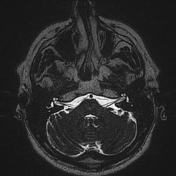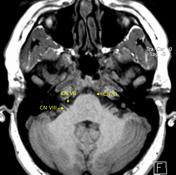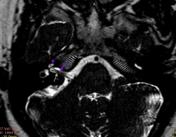Vestibulocochlear nerve
Updates to Article Attributes
The vestibulocochlear nerve (CN VIII) is the eighth cranial nerve and has two roles:
- innervation to the cochlea for hearing
- innervation to the vestibule for acceleration and balance senses
Gross anatomy
Nuclei
There are two special sensory cochlear nuclei and four special sensory vestibular nuclei located within the lower pons and upper medulla.
Vestibulocochlear nerve
It emerges between the pons and the medulla, lateral to the facial nerve and nervus intermedius, passing laterally through the cerebellopontine angle to the internal acoustic meatus (IAM) with the aforementioned two other nerves.
In the IAM the nerve splits into four bundles: cochlear nerve, superior and inferior division of the vestibular nerve and nerve from the posterior semicircular canal, separated from each other by the falciform crest and Bill bar.
Cochlear nerve
The cochlear nerve relays with the first-order sensory cells in the spiral ganglion, which is in the base of the spiral lamina.
Vestibular nerve
The vestibular nerve relays in the vestibular ganglion (a.k.a. ganglion of Scarpa), from there three bundles emerge:
- The superior division of the vestibular nerve carries sensory fibres from the hair cells of the anterior and lateral semicircular canals and utricle. It is located in the posterosuperior quadrant
- The inferior division carries sensory fibres from the saccule. It is located in the posteroinferior quadrant, along with
- The nerve from the posterior semicircular canal, also in the posteroinferior quadrant passes through the foramen singulare
Related pathology
-</ul><h4>Gross anatomy</h4><h5>Nuclei</h5><p>There are two special sensory <a title="cochlear nuclei" href="/articles/cochlear-nuclei">cochlear nuclei</a> and four special sensory <a title="vestibular nuclei" href="/articles/vestibular-nuclei">vestibular nuclei</a> located within the lower <a title="Pons" href="/articles/pons">pons</a> and upper <a title="Medulla oblongata" href="/articles/medulla-oblongata">medulla</a>.</p><h5>Vestibulocochlear nerve</h5><p>It emerges between the <a href="/articles/pons">pons</a> and the <a href="/articles/medulla">medulla</a>, lateral to the <a href="/articles/facial-nerve">facial nerve</a> and <a href="/articles/nervus-intermedius">nervus intermedius</a>, passing laterally through the <a href="/articles/cerebellopontine-angle-cistern">cerebellopontine angle</a> to the <a href="/articles/internal-acoustic-canal">internal acoustic meatus</a> (IAM) with the aforementioned two other nerves.</p><p>In the <a href="/articles/internal-acoustic-canal">IAM</a> the nerve splits into four bundles: cochlear nerve, superior and inferior division of the vestibular nerve and nerve from the posterior <a href="/articles/semicircular-canals">semicircular canal</a>, separated from each other by the <a href="/articles/falciform-crest">falciform crest</a> and <a href="/articles/bill-bar-1">Bill bar</a>.</p><h5>Cochlear nerve</h5><p>The cochlear nerve relays with the first-order sensory cells in the <a href="/articles/spiral-ganglion">spiral ganglion</a>, which is in the base of the <a href="/articles/spiral-lamina">spiral lamina</a>.</p><h5>Vestibular nerve</h5><p>The vestibular nerve relays in the <a href="/articles/vestibular-ganglion">vestibular ganglion</a> (a.k.a. ganglion of Scarpa), from there three bundles emerge:</p><ol>- +</ul><h4>Gross anatomy</h4><h5>Nuclei</h5><p>There are two special sensory <a href="/articles/cochlear-nuclei">cochlear nuclei</a> and four special sensory <a href="/articles/vestibular-nuclei">vestibular nuclei</a> located within the lower <a href="/articles/pons">pons</a> and upper <a href="/articles/medulla-oblongata">medulla</a>.</p><h5>Vestibulocochlear nerve</h5><p>It emerges between the <a href="/articles/pons">pons</a> and the <a href="/articles/medulla">medulla</a>, lateral to the <a href="/articles/facial-nerve">facial nerve</a> and <a href="/articles/nervus-intermedius">nervus intermedius</a>, passing laterally through the <a href="/articles/cerebellopontine-angle-cistern">cerebellopontine angle</a> to the <a href="/articles/internal-acoustic-canal">internal acoustic meatus</a> (IAM) with the aforementioned two other nerves.</p><p>In the <a href="/articles/internal-acoustic-canal">IAM</a> the nerve splits into four bundles: cochlear nerve, superior and inferior division of the vestibular nerve and nerve from the posterior <a href="/articles/semicircular-canals">semicircular canal</a>, separated from each other by the <a href="/articles/falciform-crest">falciform crest</a> and <a href="/articles/bill-bar-1">Bill bar</a>.</p><h5>Cochlear nerve</h5><p>The cochlear nerve relays with the first-order sensory cells in the <a href="/articles/spiral-ganglion">spiral ganglion</a>, which is in the base of the <a href="/articles/spiral-lamina">spiral lamina</a>.</p><h5>Vestibular nerve</h5><p>The vestibular nerve relays in the <a href="/articles/vestibular-ganglion">vestibular ganglion</a> (a.k.a. ganglion of Scarpa), from there three bundles emerge:</p><ol>
Image ( update )
Image ( create )
Image 3 Diagram ( create )

Image 5 Photo ( update )

Image 8 MRI (T2) ( update )

Image 10 MRI (T1 labelled) ( update )

Image 11 Annotated image (CN VIII) ( update )








 Unable to process the form. Check for errors and try again.
Unable to process the form. Check for errors and try again.